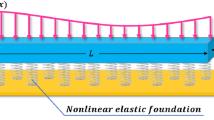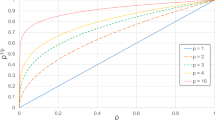Abstract
We propose a methodology to optimize the natural frequencies of functionally graded structures by tailoring their material distribution. The element-free Galerkin method is used to analyze the two-dimensional steady-state free and forced vibration of functionally graded beams. To optimize the material composition, the spatial distribution of volume fractions of the material constituents is defined using piecewise bicubic interpolation of volume fraction values that are specified at a finite number of grid points. Subsequently, we use a real-coded genetic algorithm to optimize the volume fraction distribution for three model problems. In the first problem, we seek material distributions that maximize each of the first three natural frequencies of a functionally graded beam. The goal of the second model problem is to minimize the mass of a functionally graded beam while constraining its natural frequencies to lie outside certain prescribed frequency bands. The last problem aims to minimize the mass of a functionally graded beam by simultaneously optimizing its thickness and material distribution such that the fundamental frequency is greater than a prescribed value.
Similar content being viewed by others
References
Belytschko T, Lu YY, Gu L (1994) Element free Galerkin methods. Int J Numer Methods Eng 37:229–256
Brodlie K, Mashwama P, Butt S (1995) Visualization of surface data to preserve positivity and other simple constraints. Comput Graph 19:585–594
Cheng ZQ, Batra RC (2000) Exact correspondence between eigenvalues of membranes and functionally graded simply supported polygonal plates. J Sound Vib 229:879–895
Cook RD, Malkus DS, Plesha ME, Witt RJ (2001) Concepts and applications of finite element analysis, 4th edn. Wiley, New York
Deb K (2000) An efficient constraint handling method for genetic algorithms. Comput Methods Appl Mech Eng 186:311–388
Deb K, Agrawal RB (1995) Simulated binary crossover for continuous search space. Complex Syst 9:115–148
Deb K, Agrawal S (1999) A niched-penalty approach for constraint handling in genetic algorithms. In: Proceedings of the International Conference on Artificial Neural Networks and Genetic Algorithms (ICANNGA-99), pp 235–243
Elishakoff I, Guédé Z (2004) Analytical polynomial solutions for vibrating axially graded beams. Mech Adv Mater Struct 11:517–533
Finot M, Suresh S, Bull C, Sampath S (1996) Curvature changes during thermal cycling of a compositionally graded Ni–Al\(_{2}\)O\(_{3}\) multi-layered material. Mater Sci Eng A205:59–71
Goldberg DE (1989) Genetic algorithms in search, optimization, and machine learning. Addison Wesley, New York
Goldberg DE, Deb K (1991) A comparison of selection schemes used in genetic algorithms. Found Genet Algorithms 1:69–93 (FOGA-1)
Hill R (1965) A self-consistent mechanics of composite materials. J Mech Phys Solids 13:213–222
Holland JH (1975) Adaptation in natural and artificial systems. University of Michigan Press, Ann Arbor
Lancaster P, Šalkauskas K (1981) Surfaces generated by moving least squares methods. Math Comput 37:141–158
Lancaster P, Šalkauskas K (1986) Curve and surface fitting: an introduction. Academic, London
Liu GR (2003) Mesh free methods. CRC Press, Boca Raton
Loy CT, Lam KY, Reddy JN (1999) Vibration of functionally graded cylindrical shells. Int J Mech Sci 41:309–324
Miracle DB (2001) Aeronautical applications of metal-matrix composites. In: Miracle DB, Donaldson S (eds) ASM handbook: composites, vol 21. ASM International, Materials Park, pp 1043–1049
Miyamoto Y, Kaysser WA, Rabin BH, Kawasaki A, Ford RG (1999) Functionally graded materials: design, processing and applications. Chapman & Hall, London
Mori T, Tanaka T (1973) Average stresses in matrix and average elastic energy of materials with misfitting inclusions. Acta Metall 21:571–574
Qian LF, Ching HK (2004) Static and dynamic analysis of 2-D functionally graded elasticicty by using meshless local Petrov–Galerkin method. J Chin Inst Eng 27:491–503
Qian LF, Batra RC (2005) Design of bidirectional functionally graded plate for optimal natural frequencies. J Sound Vib 280:415–424
Reiter T, Dvorak GJ (1998) Micromechanical models for graded composite materials: II. thermomechanical loading. J Mech Phys Solids 46:1655–1673
Reiter T, Dvorak GJ, Tvergaard V (1997) Micromechanical models for graded composite materials. J Mech Phys Solids 45:1281–1302
Ueda S, Gasik M (2000) Thermal-elasto-plastic analysis of W–Cu functionally graded materials subjected to a uniform heat flow by michromechanical model. J Therm Stress 23:395–409
Vel SS, Batra RC (2002) Exact solution for the cylindrical bending vibration of functionally graded plates. In: Proceedings of the American Society for Composites, seventeenth technical conference, Purdue University, West Lafayette, 21–23 October 2002
Vel SS, Batra RC (2004) Three-dimensional exact solution for the vibration of functionally graded rectangular plates. J Sound Vib 272:703–730
Wagner GJ, Liu WK (2000) Application of essential boundary conditions in mesh-free methods: a corrected collocation method. Int J Numer Methods Eng 47:1367–1379
Author information
Authors and Affiliations
Corresponding author
Rights and permissions
About this article
Cite this article
Goupee, A.J., Vel, S.S. Optimization of natural frequencies of bidirectional functionally graded beams. Struct Multidisc Optim 32, 473–484 (2006). https://doi.org/10.1007/s00158-006-0022-1
Received:
Revised:
Published:
Issue Date:
DOI: https://doi.org/10.1007/s00158-006-0022-1




